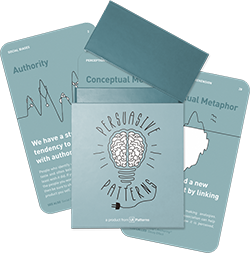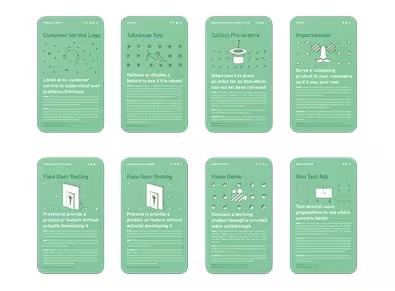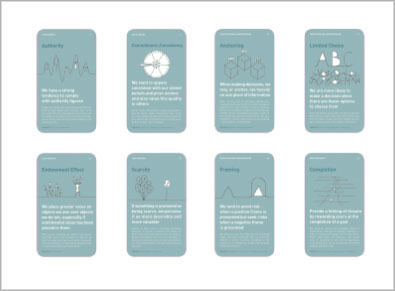Positive Mimicry
Design Pattern
Alternate titles: Mirroring, Chameleon Effect.
Problem summary
We learn by comparing our behavior with the actions of others
Usage
- Use to help users learn a new behavior
- Use when you want to enforce a feeling of liking ans similarity in your counterpart
This card is part of the Persuasive Patterns printed card deck
The Persuasive Patterns Card Deck is a collection of 60 design patterns driven by psychology, presented in a manner easily referenced and used as a brainstorming tool.
Get your deck!Solution
While positive mimicry has its advantages, it’s crucial to be cautious of over-imitation. Excessive or overt mimicry might come off as inauthentic or even creepy to the user, leading to mistrust. Moreover, relying solely on mimicry without considering the broader context or individual user needs can result in a disjointed experience. It’s also essential to remember that while mimicry can enhance familiarity, innovation should not be sidelined. Striking a balance between familiar (mimicked) patterns and novel features is key to a product’s success and user satisfaction.
The principle of positive mimicry, rooted in the human tendency to feel more comfortable with the familiar, can be a powerful tool in product design. By echoing users’ behaviors, choices, and preferences, designers can create a more intuitive and personalized user experience.
An example is adaptive learning platforms adjustoing the learning content based on a user’s performance, mimicking the tailored approach of a personal tutor. When a user struggles with certain topics, the system will offer more exercises on that subject, ensuring that the content aligns closely with the learner’s needs.
Similarly, chatbots that learn from past interactions can offer a more personalized service. Instead of providing generic responses, these chatbots can recall previous interactions, mimicking the continuity of conversation you’d expect from human-to-human dialogues. This mirroring not only improves the user’s experience but also fosters trust and rapport.
- Use your customer’s own words. Learn what language works best and how to better engage interested prospects.
- Lead the way. Demonstrate and encourage positive interactions and behaviors that users can observe and mimic.
- Highlight good behavior. In social contexts, find and reward people who model good behavior to let the crowd know what normal (or intended) behavior is.
The aim is to create a sense of familiarity without coming across as intrusive. Ethically, it’s essential to ensure that users are aware of and comfortable with how their data is being used for mimicry. Transparent communication about data usage, along with easy-to-access controls for users to manage their data, are fundamental.
Common mistakes include:
- Overpersonalization. While mimicking user behavior can create a tailored experience, taking it to an extreme might make users feel their privacy is invaded. It’s crucial to ensure that mimicry does not become surveillance.
- Assumption Errors. Just because a user behaved a certain way once doesn’t mean that behavior is a permanent preference. Relying too heavily on a single data point can lead to incorrect assumptions about user preferences.
- Lack of Transparency. Mimicry, by its nature, involves using data about the user. Not being transparent about how this data is collected, stored, and used can lead to trust issues and potential ethical concerns.
- Over-reliance on Automation. While AI and machine learning can be useful tools for implementing mimicry, it’s essential to have human oversight. Sometimes, the nuances of human behavior can be misinterpreted by algorithms.
Powerful Pairings
By understanding the synergies between positive mimicry and other persuasive patterns, designers can craft more compelling and user-centric experiences.
- Positive Mimicry + Social Proof. Integrating the power of social validation with mimicry can enhance the persuasiveness of a product. For instance, a fitness app could use positive mimicry by adapting workout routines based on user preferences, while simultaneously highlighting popular workouts among peers (social proof). This combination assures users that not only is the app personalized for them, but it’s also aligned with what’s popular or effective for others.
- Positive Mimicry + Commitment & Consistency. Once users make a small commitment, they’re more likely to act consistently with that decision. If a platform mirrors this initial commitment (e.g., a preference set in the beginning), it reinforces their decision and drives further engagement. An e-commerce site, for example, might mimic a user’s style preferences set during an initial quiz, consistently highlighting products that align with that style throughout the shopping experience.
- Positive Mimicry + Triggers. By pairing timely prompts (triggers) with positive mimicry, platforms can encourage desired behaviors. A language learning app, for instance, might send reminders (triggers) for lessons based on a user’s past activity times, mimicking their natural schedule.
Rationale
We often subconsciously and automatically imitate other people’s behavior. You smile when I smile. Mimic your customer’s terminologies, reuse search queries in your online dialogues, and showcase actual consumers buying or consuming your product.
The main psychological principle behind Positive Mimicry is the inherent human need for social cohesion and acceptance. When we mimic or are mimicked by others, it creates a sense of belonging, validation, and mutual understanding, fostering positive feelings and smoother interactions. Mimicry often occurring outside our conscious awareness, influences our perceptions, feelings, and actions.
Positive Mimicry is grounded in our evolutionary predisposition to adopt behaviors that have proven advantageous or rewarding for others in our environment. By mimicking such behaviors, individuals often hope to achieve similar positive outcomes or be perceived in a more favorable light. This principle operates both on a conscious and subconscious level, influencing a wide range of decisions and actions. While it can lead to constructive outcomes like learning and cooperation, it’s essential to recognize the boundaries and ensure it’s applied authentically and ethically.
Discussion
Positive mimicry plays a major role in psychotherapy as a tool to positively influence relationship to the client as well as a way to communicate empathy, to enhance similarity between interaction partners and increase their liking.
When platforms excessively mirror a user’s behavior or preferences, they risk creating a narrowing echo chamber. Such environments might limit users’ exposure to diverse content or experiences, potentially hindering personal growth and inadvertently reinforcing existing biases.
Moreover, the foundation of mimicry is built on understanding and replicating user behavior, which invariably involves the collection and analysis of user data. Without explicit and transparent data collection policies, this opens a Pandora’s box of privacy concerns, potentially leading to unauthorized use or even misuse of personal information.
To ethically apply the principle positive mimicry, a few guiding principles are crucial:
- Transparency. Always be transparent about how user data is being used to create a mimicked experience. Providing clear, understandable information about data collection practices will foster trust.
- Limit data collection. Only collect the data that is necessary for the mimicking process. Avoid storing excessive amounts of personal data and regularly purge unnecessary information.
- Provide opt-out options. Allow users the choice to opt-out of certain mimicking features if they’re uncomfortable with the level of personalization or if they wish to explore content outside of their typical preferences.
- Avoid reinforcing negative behaviors. Positive mimicry can inadvertently reinforce harmful or negative behaviors if not carefully managed. For instance, if a user frequently visits unhealthy food recipes, a health app shouldn’t keep suggesting similar recipes without occasionally introducing healthier alternatives.
- Data sensitivity. Some data might be more sensitive than others. For instance, mirroring browsing habits related to medical conditions or personal challenges can be seen as invasive. Designers should be discerning about which behaviors are mirrored and ensure they don’t cross personal boundaries.
Positive mimicry plays a major role in psychotherapy as a tool to positively influence relationship to the client as well as a way to communicate empathy, to enhance similarity between interaction partners and increase their liking.
1 Hess, U., Philippot, P., & Blairy, S. (1999). Mimicry: Facts and fiction. In P. Philippot, R. S. Feldman, & E. J. Coats (Eds.), The social context of nonverbal behavior (pp. 213–241). Cambridge University Press
2 Agneta H. Fischer, Daniela Becker and Lotte Veenstra (2012), Emotional mimicry in social context: the case of disgust and pride, Department of Social Psychology, University of Amsterdam
3 Chartrand, T. L., & Bargh, J. A. (1999). The chameleon effect: The perception–behavior link and social interaction. Journal of Personality and Social Psychology, 76(6), 893–910.
4 Lakin, J. L., Jefferis, V. E., Cheng, C. M., & Chartrand, T. L. (2003). The chameleon effect as social glue: Evidence for the evolutionary significance of nonconscious mimicry. Journal of Nonverbal Behavior, 27(3), 145–162.
5 van Baaren, R. B., Holland, R. W., Kawakami, K., & Van Knippenberg, A. (2004). Mimicry and prosocial behavior. Psychological Science, 15(1), 71–74.
6 Positive Mimicry behavioral change technique at Learning Loop
User Interface Design Patterns
- Forms
- Explaining the process
- Community driven
- Tabs
- Jumping in hierarchy
- Menus
- Content
- Gestures
- Tables
- Formatting data
- Images
- Search
- Reputation
- Social interactions
- Shopping
- Increasing frequency
- Guidance
- Registration
Persuasive Design Patterns
- Loss Aversion
- Other cognitive biases
- Scarcity
- Gameplay design
- Fundamentals of rewards
- Gameplay rewards


